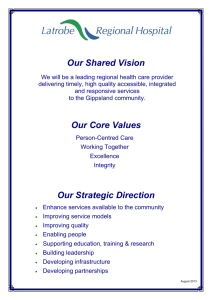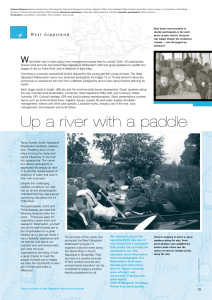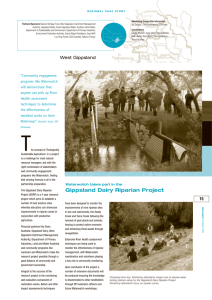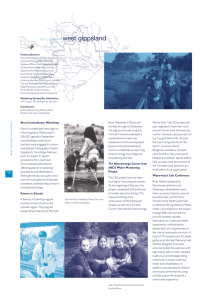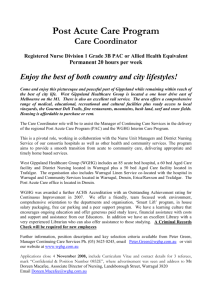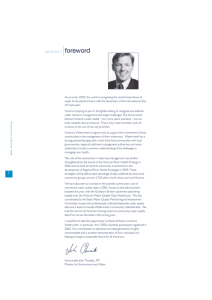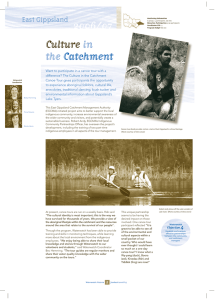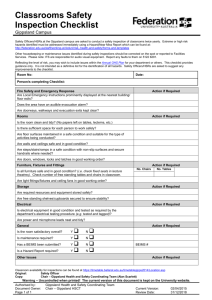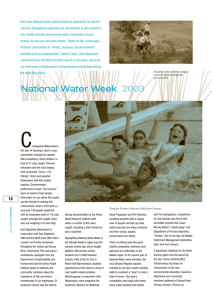connections 2007/08 West Gippsland •
advertisement
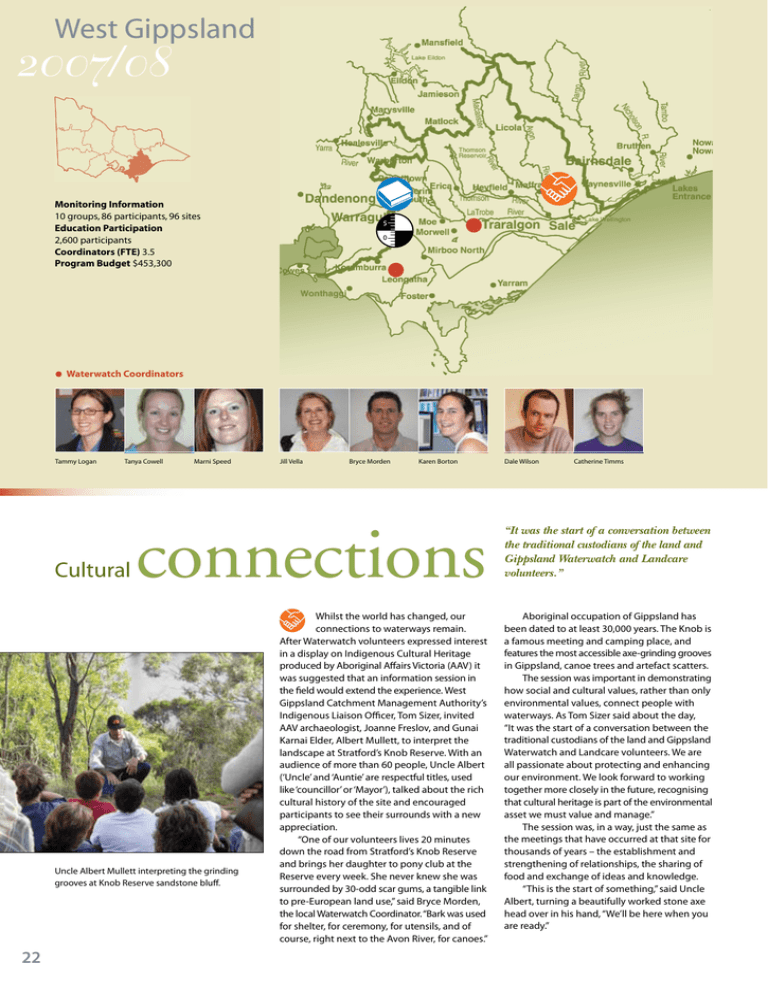
West Gippsland 2007/08 Monitoring Information 10 groups, 86 participants, 96 sites Education Participation 2,600 participants Coordinators (FTE) 3.5 Program Budget $453,300 • Waterwatch Coordinators Tammy Logan Tanya Cowell Cultural Marni Speed Bryce Morden Karen Borton connections Uncle Albert Mullett interpreting the grinding grooves at Knob Reserve sandstone bluff. 22 Jill Vella Whilst the world has changed, our connections to waterways remain. After Waterwatch volunteers expressed interest in a display on Indigenous Cultural Heritage produced by Aboriginal Affairs Victoria (AAV) it was suggested that an information session in the field would extend the experience. West Gippsland Catchment Management Authority’s Indigenous Liaison Officer, Tom Sizer, invited AAV archaeologist, Joanne Freslov, and Gunai Karnai Elder, Albert Mullett, to interpret the landscape at Stratford’s Knob Reserve. With an audience of more than 60 people, Uncle Albert (‘Uncle’ and ‘Auntie’ are respectful titles, used like ‘councillor’ or ‘Mayor’), talked about the rich cultural history of the site and encouraged participants to see their surrounds with a new appreciation. “One of our volunteers lives 20 minutes down the road from Stratford’s Knob Reserve and brings her daughter to pony club at the Reserve every week. She never knew she was surrounded by 30-odd scar gums, a tangible link to pre-European land use,” said Bryce Morden, the local Waterwatch Coordinator. “Bark was used for shelter, for ceremony, for utensils, and of course, right next to the Avon River, for canoes.” Dale Wilson Catherine Timms “It was the start of a conversation between the traditional custodians of the land and Gippsland Waterwatch and Landcare volunteers.” Aboriginal occupation of Gippsland has been dated to at least 30,000 years. The Knob is a famous meeting and camping place, and features the most accessible axe-grinding grooves in Gippsland, canoe trees and artefact scatters. The session was important in demonstrating how social and cultural values, rather than only environmental values, connect people with waterways. As Tom Sizer said about the day, “It was the start of a conversation between the traditional custodians of the land and Gippsland Waterwatch and Landcare volunteers. We are all passionate about protecting and enhancing our environment. We look forward to working together more closely in the future, recognising that cultural heritage is part of the environmental asset we must value and manage.” The session was, in a way, just the same as the meetings that have occurred at that site for thousands of years – the establishment and strengthening of relationships, the sharing of food and exchange of ideas and knowledge. “This is the start of something,” said Uncle Albert, turning a beautifully worked stone axe head over in his hand, “We’ll be here when you are ready.” Monitoring to plan Changing land use can put new and different pressures on waterways. Stakeholders need to be informed and involved in suggesting ways to alleviate those pressures. A year ago, Warragul District Landcare Group became concerned about the growing pressure on the network of creeks that run through the township of Warragul. Known collectively as Hazel Creek, it is a complex system of tributaries high up in the upper catchment of the Moe River that ultimately run to the sea through Lakes Entrance. Warragul’s stormwater drainage relies on Hazel Creek and with increasing urbanisation around the perimeters of the town, Landcare was concerned about how the creek system would handle the effects of new development. The group began monitoring at five sites and, by setting up a roster between the 12 monitors, they aim to monitor after rain events. Assisting their monitoring efforts, the Warragul Gazette has agreed to publish monthly reports on the results to help raise community awareness. The Brooker Park Wetland, situated in the centre of Warragul, is the key site in the group’s monitoring program. The data collected establishes a baseline and shows the effectiveness of the wetland as a filter and sediment trap and its role in pollution and flood mitigation. The group’s data will ultimately inform a management plan for Hazel Creek, developed by the West Gippsland Catchment Management Authority and Baw Baw Shire Council. Monitoring results from the groups five sites, together with other Waterwatch data collected since the early 1990s, will provide valuable information about where interventions are needed in order to maintain and hopefully improve the health of the Creek. As Liz Clay, a member of the Landcare group describes, “The wetlands at Brooker Park have become iconic. By establishing baseline data our monitoring not only validates the function of Brooker Park but hopefully will encourage the development of a system of wetlands.” The classroom in a Year 9 students from Neerim District Secondary College, monitoring at the water’s edge. “It is a whole different thing once they’re on the river. It’s all in context, they can see what’s around them and they can understand” A monitoring site on Hazel Creek near the Princes Highway in Warragul. (Photo: Monica Green) “The group’s data will ultimately inform a management plan for Hazel Creek.” canoe The classroom is not necessarily the best place to learn a lesson and canny teachers are changing this tradition to better engage students. A few years ago, Neerim District Secondary College teacher, Liz Keily, participated in a Waterwatch community canoe tour. The tour sparked an idea for teaching her Year 9 students an Integrated Studies Unit, based on environmental studies. Liz thought that by giving academic issues context, students would be more interested and engaged and could better apply what they were learning. So she literally took the classroom into a canoe! Every fortnight her students spend a day paddling different sections of the LaTrobe and Thomson Rivers. On each trip they undertake a number of water quality monitoring tests, habitat and macroinvertebrate assessments and have representatives from different organisations talk to them about why the rivers are important. Liz said, “You can get people from different industries to come and talk to the students in the classroom but it is a whole different thing once they’re on the river. It’s all in context, they can see what’s around them and they can understand.” Students paddle at the top end of the Lake Wellington catchment where the river winds through towering mountain ash forests, down to low lying irrigated land where agriculture and the power industry rely on the waterways for very different needs. The students have presentations from a range of stakeholders including farmers, Landcare, the power industry and the Historical Society of Walhalla, all who give a different perspective on the river. Liz summarizes the experience, “By paddling, we build up the real story about the river. Waterwatch provides another picture in that story.” Partners and Sponsors of the West Gippsland Waterwatch Program Natural Heritage Trust, West Gippsland Catchment Management Authority, Gippsland Water, South Gippsland Water, Southern Rural Water, HVP Plantations, ESSO/BHP Billiton Australia, TRU Energy, Loy Yang Power, SGS Environmental Services. 23
